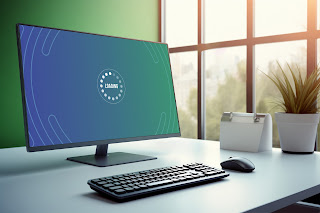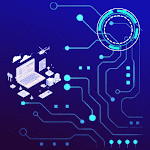HARDWARE
All of the physical parts of a computer system, including the devices attached to it, are collectively referred to as hardware, short as HW. Hardware is required to build a computer and run software. This information is being displayed on a screen, which is hardware.
What is a hardware upgrade?
A hardware update is an updated version of hardware, its replacement, or new hardware created to enhance the functionality of previous hardware. A RAM upgrade, which increases the computer's overall memory, and a video card update, which involves removing the previous GPU and installing the new one, is typical examples of hardware upgrades.
Some of the commonly used hardware in your computer are described below:
1) Motherboard:
The motherboard is generally a thin circuit board that holds together almost all parts of a computer except input and output devices. All crucial hardware like CPU, memory, hard drive, and ports for input and output devices are located on the motherboard. It is the biggest circuit board in a computer chassis.
It allocates power to all hardware located on it and enables them to communicate with each other. It is meant to hold the computer's microprocessor chip and let other components connect to it. Each component that runs the computer or improves its performance is a part of the motherboard or connected to it through a slot or port.
There can be different types of motherboards based on the type and size of the computers. So, a specific motherboard can work only with specific types of processors and memory.
Components of a Motherboard:
· · CPU Slot:
It is provided to install the CPU. It is a link between a microprocessor and a motherboard. It facilitates the use of CPU and prevents the damage when it is installed or removed. Furthermore, it is provided with a lock to prevent CPU movement and a heat sink to dissipate the extra heat.
· · RAM Slot:
It is a memory slot or socket provided in the motherboard to insert or install the RAM (Random Access Memory). There can be two or more memory slots in a computer.
· · Expansion Slot:
It appears by the names bus slot and expansion port as well. It is a port or connection on the motherboard that offers a place to add a hardware expansion card. For example, you could buy a video expansion card, put it in the expansion slot, and then install a new video card in the computer. AGP, AMR, CNR, PCI, and other popular expansion slots in computers are only a few examples.
· · Capacitor:
Two conductive plates and a thin insulator are put together to form the device. These components are contained in a plastic container.
Inductor (Coil): It is an electromagnetic coil made of a
conducting wire wrapped around an iron core. It acts as an inductor or
electromagnet to store magnetic energy.
Northbridge: It is an integrated circuit that allows
communications between the CPU interface, AGP, and memory. Furthermore, it also
allows the southbridge chip to communicate with the RAM, CPU, and graphics
controller.
USB Port: It allows you to connect hardware
devices like mouse, keyboard to your computer.
PCI Slot: It stands for Peripheral Component
Interconnect slot. It allows you to connect the PCI devices like modems,
network hardware, sound, and video cards.
AGP Slot: It stands for Accelerated Graphics Port.
It provides the slot to connect graphics cards.
Heat Sink: It absorbs and disperses the heat
generated in the computer processor.
Power Connector: It is designed to supply power to the
motherboard.
CMOS battery: It stands for complementary
metal-oxide-semiconductor. It is a memory that stores the BIOS settings such as
time, date, and hardware settings.
2) Monitor:
A monitor is the display unit of a computer on which the
processed data, such as text, images, etc., is displayed. It comprises a screen
circuity and the case which encloses this circuity. The monitor is also known
as a visual display unit (VDU).
Types of Monitors:
1.
CRT Monitor: It
has cathode ray tubes which produce images in the form of video signals. Its
main components are electron gun assembly, deflection plate assembly, glass
envelope, fluorescent screen, and base.
2.
LCD Monitor: It
is a flat panel screen. It uses liquid crystal display technology to produce
images on the screen. Advanced LEDs have thin-film transistors with capacitors
and use active-matrix technology, which allows pixels to retain their charge.
3.
LED Monitor: It
is an advanced version of an LCD monitor. Unlike an LCD monitor, which uses
cold cathode fluorescent light to backlight the display, it has LED panels,
each of which has lots of LEDs to display the backlight.
4.
Plasma Monitor: It uses plasma display technology that allows it to produce
high resolutions of up to 1920 X 1080, wide viewing angle, a high refresh rate,
outstanding contrast ration, and more.
3) Keyboard:
It is the most important input device of a computer. It is designed
to allow you input text, characters, and other commands into a computer,
desktop, tablet, etc. It comes with different sets of keys to enter numbers,
characters, and perform various other functions like copy, paste, delete,
enter, etc.
Types of Keyboards:
1.
QWERTY Keyboards
2.
AZERTY Keyboards
3.
DVORAK Keyboards
4) Mouse:
It is a small handheld device designed to control or move the
pointer (computer screen's cursor) in a GUI (graphical user interface). It
allows you to point to or select objects on a computer's display screen. It is
generally placed on a flat surface as we need to move it smoothly to control
the pointer. Types of Mouse: Trackball mouse, Mechanical Mouse, Optical Mouse,
Wireless Mouse, etc.
Main functions of a
mouse:
- Move the cursor: It
is the main function of the mouse; to move the cursor on the screen.
- Open or execute a program: It allows you to open a folder or document and
execute a program. You are required to take the cursor on the folder and
double click it to open it.
- Select: It
allows you to select text, file, or any other object.
- Hovering: Hovering
is an act of moving the mouse cursor over a clickable object. During
hovering over an object, it displays information about the object without
pressing any button of the mouse.
- Scroll: It
allows you to scroll up or down while viewing a long webpage or document.
Parts of a mouse:
- Two buttons: A
mouse is provided with two buttons for right click and left click.
- Scroll Wheel: A
wheel located between the right and left buttons, which is used to scroll
up and down and Zoom in and Zoom out in some applications like AutoCAD.
- Battery: A
battery is required in a wireless mouse.
- Motion Detection Assembly: A mouse can have a trackball or an optical sensor
to provide signals to the computer about the motion and location of the
mouse.
1) System Software
The system software is the main software that runs the computer.
When you turn on the computer, it activates the hardware and controls and
coordinates their functioning. The application programs are also controlled by
system software. An operating system is an example of system software.
i) Operating System:
An operating system is the system software that works as an
interface to enable the user to communicate with the computer. It manages and
coordinates the functioning of hardware and software of the computer. The
commonly used operating systems are Microsoft Windows, Linux,
and Apple Mac OS X.
Some other examples of
system software include:
- BIOS: It
stands for basic input output system. It is a type of system software,
which is stored in Read Only Memory (ROM) located on the motherboard.
However, in advanced computer systems, it is stored in flash memory. BIOS
is the first software that gets activated when you turn on your computer
system. It loads the drivers of the hard disk into memory as well as
assists the operating system to load itself into the memory.
- Boot Program: Boot
refers to starting up a computer. When you switch on the computer, the
commands in the ROM are executed automatically to load the boot program
into memory and execute its instructions. The BIOS program has a basic set
of commands that enables the computer to perform the basic input/output
instructions to start the computer.
- An assembler: It
plays the role of a converter as it receives basic computer instructions
and converts them into a pattern of bits. The processor uses these bits to
perform basic operations.
- A device driver: This
system software controls hardware devices connected to a computer. It
enables the computer to use the hardware by providing an appropriate
interface. The kernel of a Computer's CPU communicates with different
hardware through this software. Operating systems generally come with most
of the device drivers. If the operating system does not have a device
driver for hardware, you have to install the device driver before using
that hardware device.
2) Application
Software:
Application software is a set of programs designed to perform a
specific task. It does not control the working of a computer as it is designed
for end-users. A computer can run without application software. Application
software can be easily installed or uninstalled as required. It can be a single
program or a collection of small programs. Microsoft Office Suite, Adobe
Photoshop, and any other software like payroll software or income tax software
are application software. As we know, they are designed to perform specific
tasks. Accordingly, they can be of different types such as:
- Word Processing Software: This software allows users to create, edit,
format, and manipulate the text and more. It offers lots of options for
writing documents, creating images, and more. For example, MS Word,
WordPad, Notepad, etc.
- Spreadsheet Software: It
is designed to perform calculations, store data, create charts, etc. It
has rows and columns, and the data is entered in the cell, which is an
intersection of a row and column, e.g., Microsoft Excel.
- Multimedia Software: These
software are developed to perform editing of video, audio, and text. It
allows you to combine texts, videos, audio, and images. Thus, you can
improve a text document by adding photos, animations, graphics, and charts
through multimedia software. For example, VLC player, Window Media Player,
etc.
- Enterprise Software: These
software are developed for business operational functions. It is used in
large organizations where the quantum of business is too large. It can be used
for accounting, billing, order processing and more. For example, CRM
(Customer Relationship Management), BI (Business Intelligence), ERP
(Enterprise Resource Planning), SCM (Supply Chain Management), customer
support system, and more.
3) Programming Software:
It is a set or collection of tools that help developers in
writing other software or programs. It assists them in creating, debugging, and
maintaining software or programs or applications. We can say that these are
facilitator software that helps translate programming language such as Java, C++, Python,
etc., into machine language code. So, it is not used by end-users. For example,
compilers, linkers, debuggers, interpreters, text editors, etc. This software
is also called a programming tool or software development tool.
Some examples of programming software include:
- Eclipse: It
is a java language editor.
- Coda: It
is a programming language editor for Mac.
- Notepad++: It
is an open-source editor for windows.
- Sublime text: It is a cross-platform code editor for Linux, Mac, and Windows.

.gif)




.jpg)




.gif)
.gif)

.gif)

.gif)